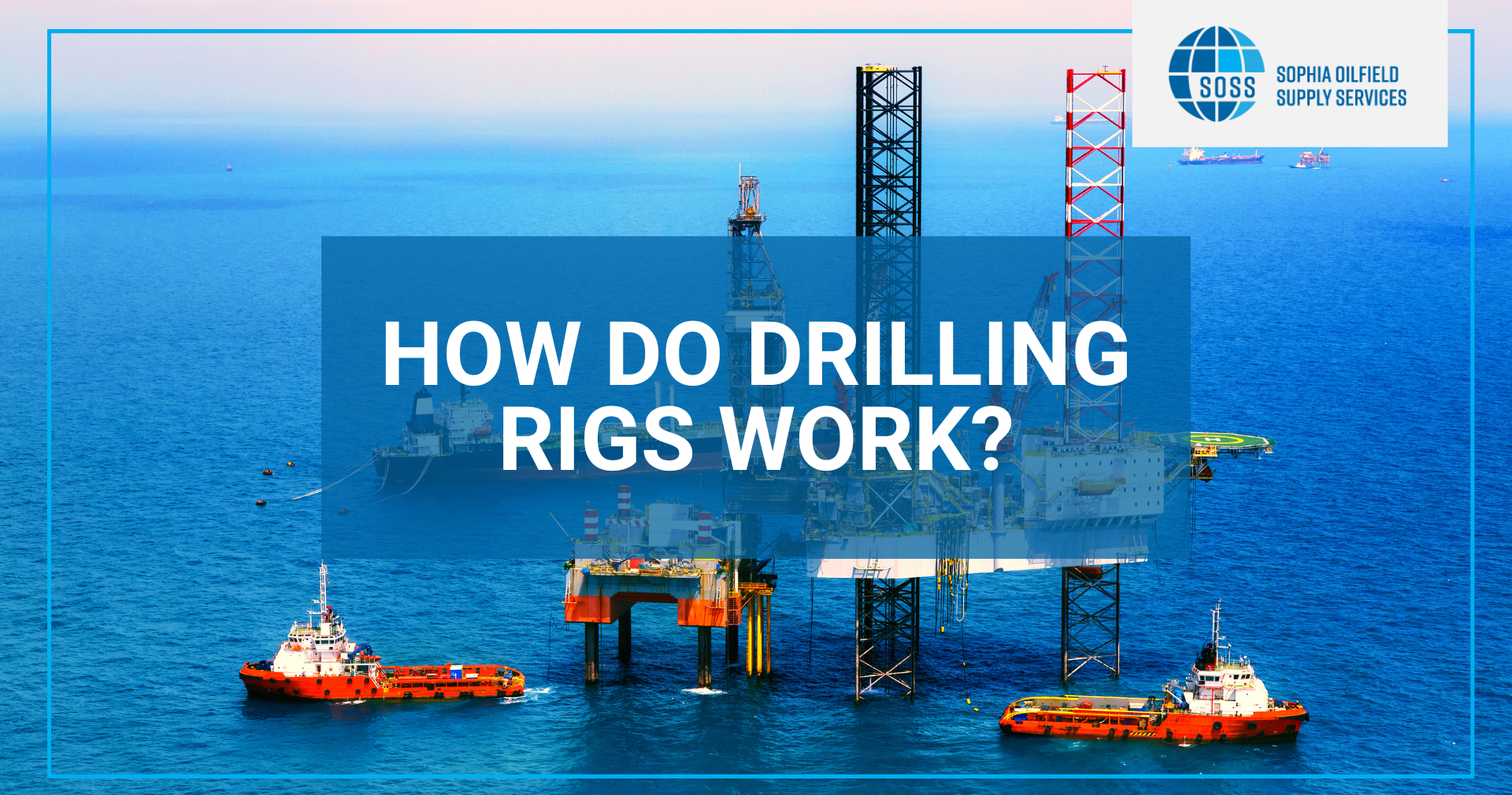The process of drilling oil wells is highly demanding and sophisticated, requiring exceptionally skilled personnel and specialized tools and equipment. To extract natural resources from the earth, creating a hole by penetrating the sub-surface is crucial.
Several pieces of equipment and machinery play a pivotal role in the drilling process, including but not limited to a drill bit, drill pipe, derrick, mud pump, draw works, and much more.
That is where a drill rig becomes a vital part of the drilling procedure. This essential structure holds various components that work in conjunction to drill wells for oil, gas, and minerals. But how do drilling rigs work? Read on to find out!
What Are Drilling Rigs?
Oil drilling rigs are complex mechanical structures designed to create oil wells by drilling deep holes into the surface. They can be small, mobile equipment to massive structures that help explore and extract oil and gas by penetrating the crust.
Oil rigs can be divided into land or surface drilling rigs and offshore rigs. Land rigs are used for onshore drilling or under the dry surface, while offshore rigs are installed in the waters.
A land rig can be either conventional or mobile. Conventional rigs have large components transported and assembled on the drilling site in different units. In contrast, mobile rigs are typically mounted on trucks or trailers as a single unit, offering ease of mobility between different drilling sites.
An offshore drilling rig is transported and set up using specialized marine vessels and platforms. It can be a bottom-supported rig in contact with the seafloor or a floating rig not attached to the seabed. Offshore rigs can include fixed platforms, semi-submersibles, drillships, and jack-up rigs, each suited to different water depths and environmental conditions.
Rotary drilling rigs are the most common oil rigs and can dig up to five miles beneath the surface. They feature rotary equipment that twists the drill string and the drill bit to dig into the surface. Rotary rigs perform continuous and rapid rotations that can penetrate hard formations quickly, reducing drilling time and saving costs while enhancing drilling efficiency.
If you’re curious about the factors involved in determining drilling rig cost, it’s important to consider variables such as size, type, and operational requirements, which can significantly influence the price.
How Do Drilling Rigs Work?
After the well location has been chosen by geologists, the site is cleared and leveled to prepare for the drilling rig setup. After the drilling rig has been brought to the location and assembled, there are five main drilling rig systems that enable a successful drilling operation.
These include:
Hoisting System
The hoisting system in a drill rig raises and lowers the drill string and other equipment, such as casing and tubing, in and out of the wellbore. It consists of a tall structure called the derrick or mast, which supports the hoisting equipment like the drilling lines and drawworks.
The main hoisting component, the drawworks, is a winch that uses a large drum to reel in or reel out the drilling line to lift or lower the drill string and other equipment.
Power System
Modern drilling rigs are typically powered by large diesel engines and generators, or electric motors. The power system mainly includes diesel engines that provide energy to the rotary rig components like the top drive and mud pumps through generators. Diesel engines combined with generators convert mechanical energy to provide electrical power. These generators produce AC (alternating current) and DC (direct current) power.
Some rigs may use electric motors directly to power the rotary system. These motors can be powered by generators driven by diesel engines or connected to the power grid.
Rotary System
The drill bit is attached to the bottom of the drill string, which creates a hole in the surface. The rotating system can either be a top drive mounted on the derrick or a rotary table on the drill floor that provides the required torque and weight to the drill string, which turns the rotary drill bit.
The drill collar below the new or used drill pipe applies the downward force needed to cut through the ground.
Circulating System
The circulating system circulates the drilling mud through the drill string from the mud pump. It removes and carries the rock cuttings produced during the extraction process from the hole to the surface while lubricating the drill string and supporting the borehole wall by controlling formation pressure.
The cuttings are removed from the drilling mud using shale shakers, and the mud is sent down the hole again.
Blowout Prevention/ Well Control System
The well control or blowout prevention system is vital for efficient and effective drilling operations, the safety of rig personnel, and mitigating environmental damage. Its main function goal is to manage the flow of kick fluids within the wellbore and prevent blowouts or explosions due to uncontrolled, high-pressure release of formation fluids like oil and gas from the well.
The blowout preventers are large specialized valves and the most critical component of the well control system. Other major components include the accumulator that provides the necessary energy to swiftly activate the blowout preventer and seal the well in an emergency and choke manifolds that circulate drilling fluid and control pressure.
Beyond initial drilling, maintaining and servicing wells is crucial. Learning what workover rigs are can help you understand how to handle well repairs and maintenance, keeping operations smooth and productive long after the first drill.
Types of Rigs
Drill rigs come in different types to suit specific drilling conditions, such as varying water depths. While some rigs rest on the seabed, others float above the water. Some of the most common types of offshore rigs include the following.
To learn more about the different types of drilling rigs, you can explore how they work and what makes each one unique.
Barges
Barge rigs operate in calm and shallow waters less than 20 feet deep. These floating barges feature drilling equipment and are towed to the drilling location, where the hull is made to rest on the seafloor without sinking into the mud, ensuring stability during drilling operations.
Submersible Rigs
Submersible rigs are offshore rigs well-suited for shallow waters up to 80 feet deep. The lower hull is submerged in the seabed at the drill site until it sits on the ocean floor, allowing the structure to remain stable while the platform or upper hull remains above water.
After the drilling, the water is pumped out of the ballast tanks in the lower hull, and the rig can be transported to a new location.
Semi-submersible Rigs
Semi-submersible rigs are offshore drilling rigs that float on the water surface instead of resting on the seabed. They are suitable for drilling deep waters at depths over 300 and up to 10,000 feet.
The rigs are supported by pontoons and anchors below the hull and under the water that offer stability and keep it in position during varying waves or currents.
Jackup Rigs
Jackup rigs are used for shallow waters less than 400 feet deep. These offshore drilling rigs feature long and extendable steel legs.
Once at the drilling location, the legs are lowered to the seafloor to raise the hull or platform above the water surface through hydraulic jacks. As the legs jack up the hull, it offers drilling stability by protecting the platform from winds and varying tides.
If you’re interested in exploring how deep drilling rigs go, jackup rigs are typically used in shallower waters, while other rigs are designed for much deeper drilling.
A jackup rig is mobile, so it can be conveniently moved to different locations, making it a versatile and suitable option for exploratory drilling in various shallow water areas.
Drillships
Drillships are self-propelled, highly mobile vessels suitable for drilling at depths exceeding 10,000 feet and remote locations.
They have the drilling apparatus mounted in the center of the deck and dynamic positioning to maintain its vertical position over the drilling site without the use of anchors. The hull features a hole through which the drilling equipment or the drill string is lowered into the sea.
Platform Rigs
Platform rigs are types of offshore drilling rigs that are installed on permanent structures called platforms. These platforms are made of steel or concrete and fixed to the seabed with the rig equipment mounted on it. Platform rigs can be found in various offshore environments, ranging from shallow to deep waters.
About Sophia Oilfield Supply Services
Sophia Oilfield Supply Services is a leading and trusted distributor of drilling products and equipment. With more than 30 years of experience selling oilfield equipment, we realize the importance of high-quality drilling rigs for safe and efficient drilling. Our rigs are manufactured with the highest drilling industry standards to ensure maximum longevity and efficiency.
Browse our wide variety of new and used drilling rigs for sale designed to deliver peak performance in the most demanding drilling conditions.
Contact us today for a customized estimate for our drilling rigs, and our team of oilfield experts is ever ready to assist you in choosing the suitable drill rigs for your drilling needs, ensuring operational excellence on the oilfield.

